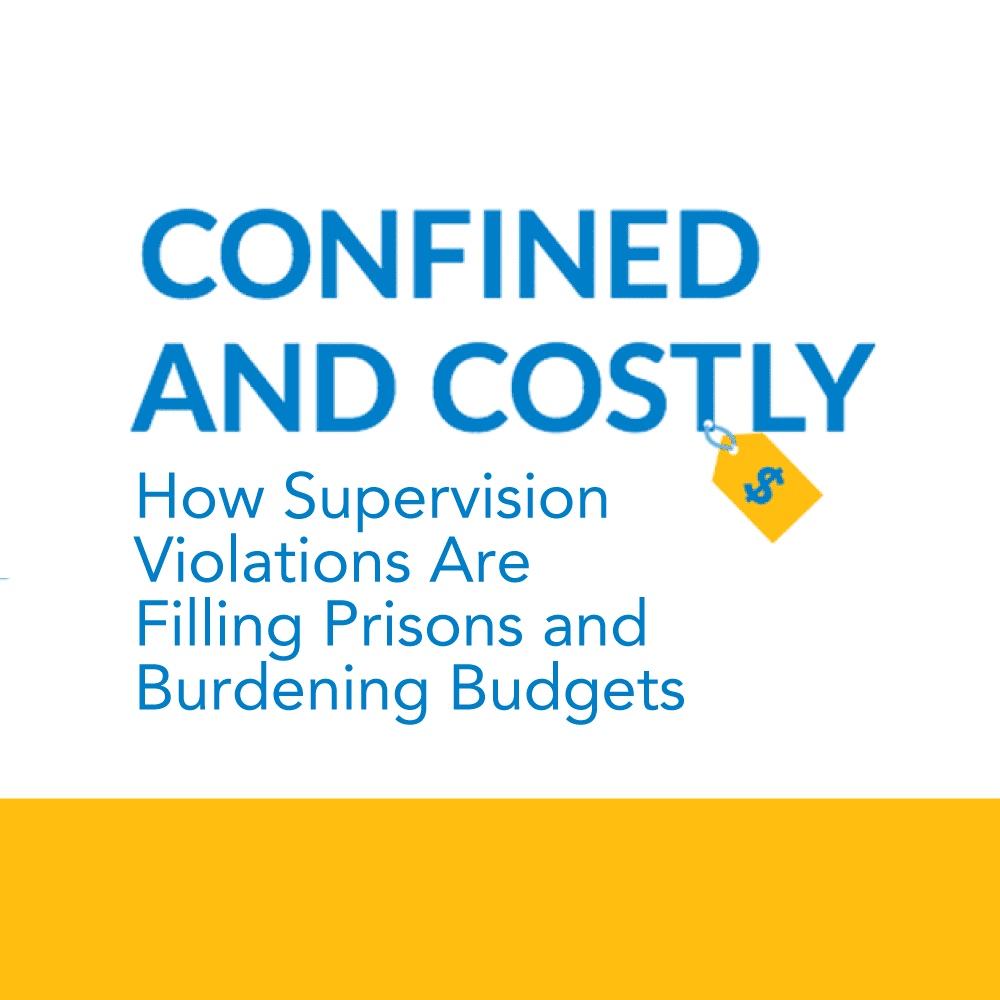Probation and parole are designed to lower prison populations and help people succeed in the community. New data show they are having the opposite effect. Until now, national data regarding the impact of probation violations on prison populations have been unavailable, resulting in a lopsided focus on parole. The Council of State Governments (CSG) Justice Center recently engaged corrections and community supervision leaders in 50 states to develop the first complete picture of how probation and parole violations make up states’ prison populations. The analysis revealed a startling reality.
Confined and Costly
How Supervision Violations Are Filling Prisons and Burdening Budgets
Confined and Costly: How Supervision Violations Are Filling Prisons and Burdening Budgets
In 2019, the CSG Justice Center engaged corrections and community supervision leaders in 50 states to develop the first complete picture of how probation and parole violations make up states’ prison populations. NOTE: View the most recent version of this report at Supervision Violations and Their Impact on Incarceration.
This report was originally released in 2019, but more updated information can be found at Supervision Violations and Their Impact on Incarceration. View the new report to learn more.
How Supervision Violations Are Filling Prisons and Burdening Budgets
45% of state prison admissions nationwide are due to violations of probation or parole for new offenses or technical violations.1
Technical violations, such as missing appointments with supervision officers or failing drug tests, account for nearly
1/4 of all state prison admissions.
Definitions of terms appear below. For more complete definitions, see our methodology.
On any given day, 280,000 PEOPLE in prison—nearly 1 IN 4—are incarcerated as a result of a supervision violation, costing states more than $9.3 BILLION ANNUALLY.
Technical supervision violations account for $2.8 BILLION of this total amount, and new offense supervision violations make up $6.5 BILLION. These figures do not account for the substantial local costs of keeping people in jail for supervision violations.
In 13 states, more than 1 in 3 people
in prison on any given day are there for a supervision violation.
*Data on violations as a proportion of prison population not available for CT, ME, NH, NM, VT.
In 20 states, more than half of prison admissions
are due to supervision violations.
Variation in these proportions across states is shaped by the overall size of each state’s supervision population, how violations are sanctioned, whether those sanctions are the result of incarceration paid for by the state or county, and how well state policy and funding enable probation and parole agencies to employ evidence-based practices to improve success on supervision.
*Technical breakdown not available for CT, GA, MA, MD, MI, MN, NC, NH, NM, OK, and PA. Data on violations as a proportion of prison admissions not available for DE and VT.
Key Questions
States Should Ask
As state leaders begin to address supervision violations in their state, these questions should guide decision-making:
- How many people in your state are on probation or parole?
- How are technical violations handled in your state?
- What impact do supervision violations have on local jails in your state?
- How do your state’s policies impact the length of time that people are on probation and parole?
- For what types of new offenses are people on supervision being sent to prison?
- What has your state done to scale up implementation of supervision practices and programs designed to reduce new criminal behavior?
- How much does your state invest in supervision annually? How much do supervision violations cost your state annually?
Definitions
- Violation total: Admissions to state-funded incarceration as a result of a violation of supervision conditions.
- Non-violation total: Admissions to state-funded incarceration that were not the result of a violation of supervision conditions.
- Probation total: Admissions to state-funded incarceration as a result of a violation of probation supervision conditions.
- Parole total: Admissions to state-funded incarceration as a result of a violation of parole or post-prison supervision conditions.
- Probation new offense: Admissions to state-funded incarceration as a result of a new offense violation of probation conditions.
- Parole new offense: Admissions to state-funded incarceration as a result of a new offense violation of parole or post-prison supervision conditions.
- Probation technical: Admissions to state-funded incarceration as a result of a technical violation of probation conditions.
- Parole technical: Admissions to state-funded incarceration as a result of a technical violation of parole or post-prison supervision conditions.
Methodology
In 2018, the CSG Justice Center developed a survey to collect data on the impact of supervision violations on prison admissions and population and distributed the survey to corrections departments in all 50 states. Forty-six states submitted survey data, and data was acquired through other means (i.e., publicly available reports) in an additional three states. In total, data was acquired on at least one of the requested metrics for 49 states. The data presented in this report is a direct reflection of reporting by state corrections departments and did not include any original analysis by CSG Justice Center staff. It is possible that a more in-depth analysis would result in a different picture for some states, namely that a greater share of prison admissions and population would be due to technical violations. For complete methodology, see our methodology.
 New Hampshire Continues Justice Reinvestment Effort to Improve Conditions for People Who Are High Utilizers of Criminal Justice and Behavioral Health Systems
Read More
New Hampshire Continues Justice Reinvestment Effort to Improve Conditions for People Who Are High Utilizers of Criminal Justice and Behavioral Health Systems
Read More
 New Hampshire Commission Reviews Final Policy Recommendations to Reduce Reliance on Incarceration as Part of Justice Reinvestment Initiative
Read More
New Hampshire Commission Reviews Final Policy Recommendations to Reduce Reliance on Incarceration as Part of Justice Reinvestment Initiative
Read More
 Three Things to Know About New Jersey’s Groundbreaking Community Response Legislation
Three Things to Know About New Jersey’s Groundbreaking Community Response Legislation
In response to growing calls for police reform in New Jersey, particularly…
Read More













